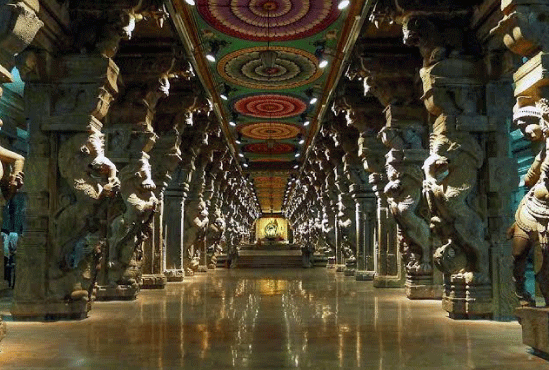Madurai Meenakshi TempleIndia is famous for its beautiful intangible culture and phenomenal temple architecture of the ancient and medieval periods. Some of the temples are built so that they are the engineering marvel of the period they are built-in like Brihadeshwara Temple. Though temples have always been an important part of Hindu and Indian traditions, temples of the south built by the rulers of southern dynasties are unique in their architecture. In this article, we are going to discuss one such beautiful temple of south Madurai, Meenakshi Temple. The complete name of this famous temple is Arulmigu Meenakshi Amman Temple, and it is also famous as Meenakshi Sundareshwar Temple. Some historians also claim that the temple is as old as the city of Madurai. The temple is managed and governed by the Hindu Religious and Charitable Endowments Departments. 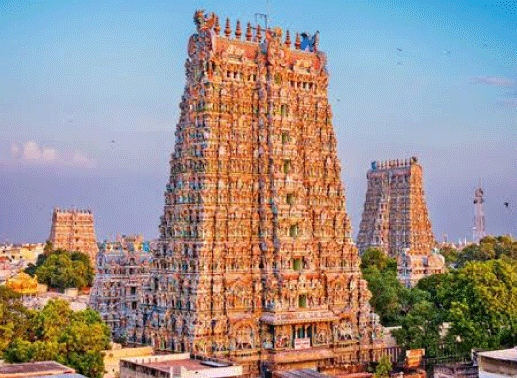
HistoryMadurai is an ancient South Indian city that is also famous as the Temple City. The city of Madurai is also mentioned in the ancient Tamil literature Sangam Literature. This ancient historic temple is built on the River Vaigai's southern bank in Madurai, Tamil Nadu. This beautiful Dravidian Style Temple was built in the mid-6th-century C.E by the Emperor of the Pandyan Dynasty, Sadayavarman Kulashekaran I. The temple is dedicated to the form of Parvati and Shiva as Goddess Meenakshi and Lord Sundareshwar. 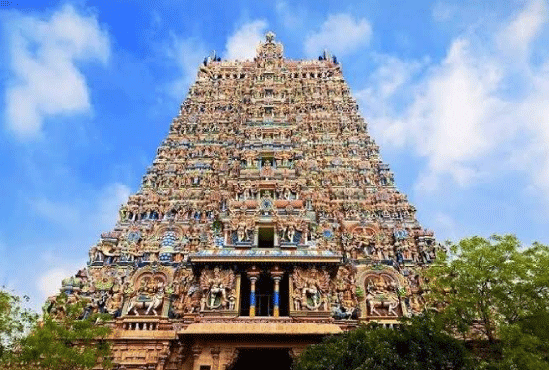
According to some texts, Goddess Meenakshi was the divine ruler of the Tamil kingdom and is worshipped as the primary deity along with Lord Sundareshwar (Shiva). Sometimes it is also referred to as Velliambalam - the silver hall where Lord Shiva Danced or Kadambavanam - the forest of Kadamba. There is also a mention of the place in the Sanskrit Text Halasya Mahatmya and Tamil Text Tiruvilayadalpuranam. It is also counted as a shrine among the 275 Paadal Petra Sthalams or also famous as Thevara Sthalam. In the 6th - 9th centuries, these were the temples that were revered in the verses of Saiva Nayanars. It was also one of the greatest Shiva Temple on the continent. This temple was mentioned in the 7th century by a famous Hindu saint named Thirugnanasambandar, who was a Saiva Philosopher and described the deity as Alavai Iraivan. The principal deity Goddess Meenakshi is also known as Alavai Annal and Angayar Kanni Ammai. Invasion and Destruction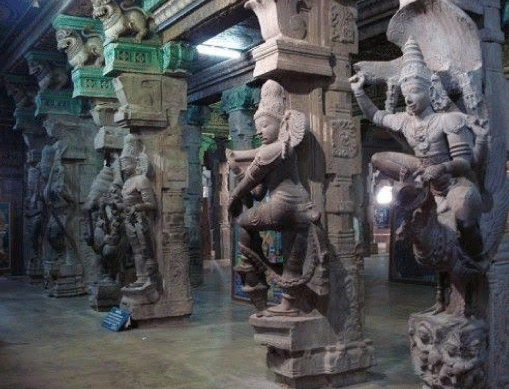
When the Delhi Sultanate was established in the north in the 14th century AD things got more complicated. When Allaudin Khalji sat on the throne of Delhi Sultanate, he started raiding deep in the South Indian kingdoms. He defeated many Rulers of different dynasties by sending his infamous eunuch General Malik Kafur along with his army of Delhi Sultanate, who raided the city of Madurai, looted the temple, and destroyed it, which was the source of enormous jewels and gold. In the 14th century AD, the Islamic invasion brought an abrupt end to the patronage of Tamil Hindu Temple cities. During the 16th and 17th centuries, Vishwanath Nayak, the ruler of the Hindu Nayaka Dynasty, rebuilt the temple and the city of Madurai following the Shilpa Shastras, a Hindu Text on Architecture. Vishwanathan Nayaka completed the work. In 1560 during the reign of Tirumala, Nayaka expanded to the current structure. He built Vasantha Mandapam for the celebration of the spring festival Vasanthotsavam and the Corridor of Parrots Kilikoondu Mandapam. Rani Mangammal built the Meenatchi Nayakar Mandapam and corridors of the temple tank. The prime minister of the Nayaka Dynasty, Ariyanatha Mudaliar, also bought some changes to the structure of the temple. In 1995 they celebrated the complete restoration of the temple, by organizing Kumbhabhishekam. MythologyIn south India, the principal deity of the majority of the temples is Shiva, but in the Madurai Meenakshi temple, the principal deity is Goddess Meenakshi. According to the legends of the Tamil Text, Tiruvilaiyayatpuranam a Yajna was performed by King Malayadwaja Pandya and his wife, Kanchanamalai. They were seeking a son for the succession of the throne, but to their dismay, a three-year-old girl was born with three breasts out of the fire. The King and his wife were worried about the abnormality of their daughter, but the divine voice instructed them to accept her as she was and raise her like the heir to the throne. Following the instructions, the King crowned her as successor when she grew up. There was also a forecast at the time of her birth that when she meets her husband, she will lose her third breast and when she meets Shiva, the words come true, and she changes into her true form of Meenakshi. According to Harman, it also reflects the South Indian tradition of matrilineal and the "regional belief of spiritual power rests with women". Gods listen to their spouses, and the kingdom's fate rests with the women. Architecture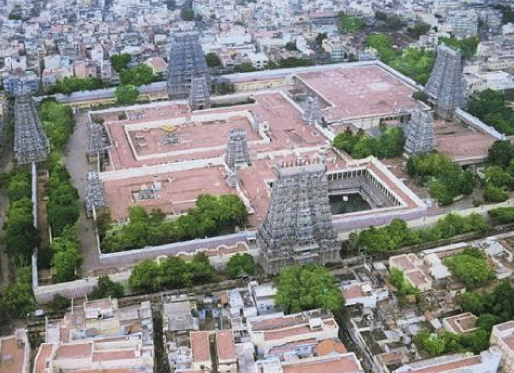
The architecture of the temples in south India has specific outlay and design, and most of the temples are built in the Nagara design. Madurai Meenakshi Sundareshwar Temple was built in the Dravidian Style Architecture by the Pandya King Sadayavarman Kulasekaran I (1190-1205). The earliest surviving main part at the entrance of the Sundareshwar shrine i.e., the three-storeyed Gopura, is built by King Kulsekarana I. The other earliest surviving part of the temple is the central portion of the shrine of Goddess Meenakshi. As he was famous as a poet, he has also written a poem on Goddess Meenakshi named Ambikai Malai. The temple is built over a huge area over 14acres in the heart of Madurai and enclosed with high rising walls to safeguard it from invasion. The entire structure and outlay of the temple represent a Mandala when viewed from above. Now you must be wondering what a Mandala is? Well, it is a structure that is built according to the laws of loci and symmetry. There are many shrines in the complex of the temple. There are two main shrines of Goddess Meenakshi and Lord Sundareswar, and there are five more shrines dedicated to different gods and goddesses like Ganesha, Murugan, Saraswati, Rukmini, and Lakshmi. They built the Vimanas above the Garbhgriha ( sanctum where the main deity is situated) of sundarewara, and Meenakshi gilded with gold. The temple complex also has a pond named Porthamarai Kulam which means Pond with a Golden Lotus. The lotus is placed in the middle of the pond. According to the Tamil folklore, the pond act as an evaluator as it reviews the worth of any new literature. 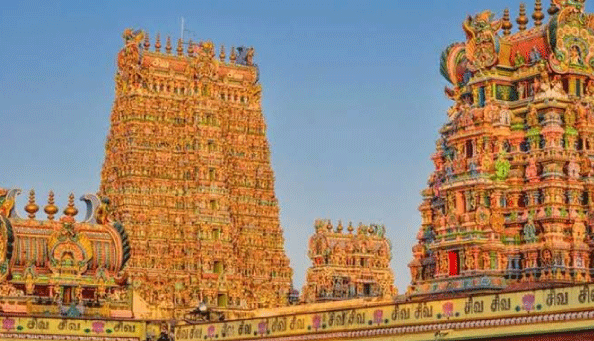
The temple has four main identical Gopuram (towering gateways). Apart from these four main Gopurams, there is another gopuram to many shrines and act as their gateways. There are a total of 14 Gopuram in the temple's complex. All the Gopuram are multi-story and displays some sculptures and thousands of mythological stories. Some of the main Gopuram of the temple are-
Worship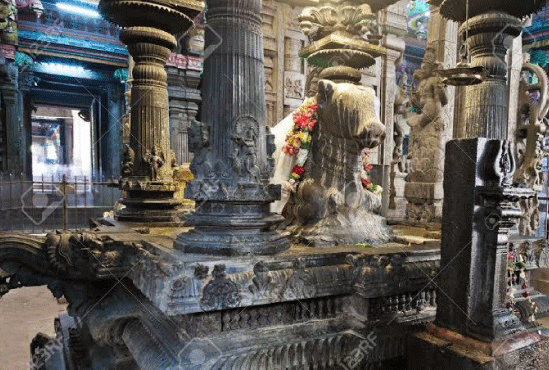
The ritual of worship is performed every day. They symbolically move the Sundareswar's icon in a palanquin to the chamber of Meenakshi and then wake the two in the morning and return lord Sundareswar to his shrine. The Pooja is performed six times every day that comprises the four main rituals - Abhisheka (sacred bath), Alangaram (decorations), Neivethanam (food offerings), and Deepa Aradanai (lamp ceremony) for both the main deities of the temple. Music plays an important part in every ritual and festival; they play instruments like - Nadhaswaram (pipe instrument), and Tavil (percussion instrument) along with recitations from Vedas. Festivals
The temple hosts many festivals in almost every month of the Tamil calendar, and some of them are so popular that it attracts more than millions of people; one such festival is called Meenakshi Thirukalyanam, which is the wedding festival of Goddess Meenakshi. It is celebrated for 12 days in the Tamil month of Chithirai, which mostly falls in April. During this festival, they organize a procession in a chariot where the icons of goddess Meenakshi and lord Sundareswar are placed. The devotees and temple volunteers then pull the chariot. In one month, there are many events organized by the temple, such as Theppa Thiruvizhah ( float festival ) and Ther Thiruvizhah (chariot festival). Thousands of devotees celebrate the 10day festival called Avani Moola Utsavam from July to August, i.e., the Tamil month of Aadi. Among other festivals that the devotees are celebrating include the Unjal Festival in The month of Aani, the Vasantham Festival in the month of Vaikasi, and the festival of Mulai Kottu in the month of Aadi. The temple also celebrates the festival of Navarathri during the month of Purattasi. Significance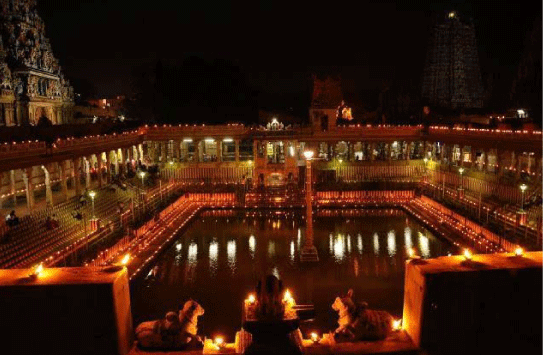
The temple of Goddess Meenakshi is significant for Hindus culturally and theologically. It has been more elegantly explained by Professor Christopher Fuller, who states that - "Through the wedding of Meenakshi and Sundareswar it depicts women's most important rite of passage. It defines the cultural concept of auspicious married women or sumangali. This signifies a married woman living with her husband, but at the same time, she is independent and organized in her social connection." It is central to Tamilian life. This temple is also significant as Shiva is the husband of Meenakshi and Vishnu is her brother, which symbolizes the protective relationship between Vaishnavism and Shaivism tradition. It also signifies the relationship of the Dravidian kinship system. According to the Tamil's Tiruvilaiytal Puranam, there is a total of 68 pilgrimage places in Shaivism, but out of these, four are the most important: Kashi ( Varanasi), Madurai, Tirukkalatti, and Chidambaram. There is a notion of belief in the traditions of Tamil Hindus that Shiva has performed Cosmic Dance on Panchayat Sabhai (five courts), and the Sundareswar shrine is one of them. There is a massive Nataraja Sculpture which is enclosed in Velli Ambalam (silver abode, in Tamil, Velli means silver, and Ambalam means stage or altar). The temple also serves as a popular site for Hindu weddings. The Meenakshi temple is not just a religious center but also an economic center. Tourists and goods and services for pilgrims are a significant part of the Madurai economy. The state emblem of the state of Tamil Nadu is based on the West Gopuram.
Next TopicMahabodhi Temple
|
 For Videos Join Our Youtube Channel: Join Now
For Videos Join Our Youtube Channel: Join Now
Feedback
- Send your Feedback to [email protected]
Help Others, Please Share





